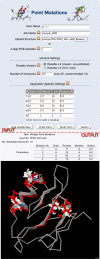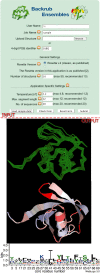RosettaBackrub--a web server for flexible backbone protein structure modeling and design
- PMID: 20462859
- PMCID: PMC2896185
- DOI: 10.1093/nar/gkq369
RosettaBackrub--a web server for flexible backbone protein structure modeling and design
Abstract
The RosettaBackrub server (http://kortemmelab.ucsf.edu/backrub) implements the Backrub method, derived from observations of alternative conformations in high-resolution protein crystal structures, for flexible backbone protein modeling. Backrub modeling is applied to three related applications using the Rosetta program for structure prediction and design: (I) modeling of structures of point mutations, (II) generating protein conformational ensembles and designing sequences consistent with these conformations and (III) predicting tolerated sequences at protein-protein interfaces. The three protocols have been validated on experimental data. Starting from a user-provided single input protein structure in PDB format, the server generates near-native conformational ensembles. The predicted conformations and sequences can be used for different applications, such as to guide mutagenesis experiments, for ensemble-docking approaches or to generate sequence libraries for protein design.
Figures



Similar articles
-
Predicting the tolerated sequences for proteins and protein interfaces using RosettaBackrub flexible backbone design.PLoS One. 2011;6(7):e20451. doi: 10.1371/journal.pone.0020451. Epub 2011 Jul 18. PLoS One. 2011. PMID: 21789164 Free PMC article.
-
Backrub-like backbone simulation recapitulates natural protein conformational variability and improves mutant side-chain prediction.J Mol Biol. 2008 Jul 18;380(4):742-56. doi: 10.1016/j.jmb.2008.05.023. Epub 2008 May 17. J Mol Biol. 2008. PMID: 18547585 Free PMC article.
-
Protinfo PPC: a web server for atomic level prediction of protein complexes.Nucleic Acids Res. 2009 Jul;37(Web Server issue):W519-25. doi: 10.1093/nar/gkp306. Epub 2009 May 6. Nucleic Acids Res. 2009. PMID: 19420059 Free PMC article.
-
Dynamics, a Powerful Component of Current and Future in Silico Approaches for Protein Design and Engineering.Int J Mol Sci. 2020 Apr 14;21(8):2713. doi: 10.3390/ijms21082713. Int J Mol Sci. 2020. PMID: 32295283 Free PMC article. Review.
-
Macromolecular modeling and design in Rosetta: recent methods and frameworks.Nat Methods. 2020 Jul;17(7):665-680. doi: 10.1038/s41592-020-0848-2. Epub 2020 Jun 1. Nat Methods. 2020. PMID: 32483333 Free PMC article. Review.
Cited by
-
Structural signature of the G719S-T790M double mutation in the EGFR kinase domain and its response to inhibitors.Sci Rep. 2014 Aug 5;4:5868. doi: 10.1038/srep05868. Sci Rep. 2014. PMID: 25091415 Free PMC article.
-
The search of sequence variants using a constrained protein evolution simulation approach.Comput Struct Biotechnol J. 2020 Jun 17;18:1790-1799. doi: 10.1016/j.csbj.2020.06.018. eCollection 2020. Comput Struct Biotechnol J. 2020. PMID: 32695271 Free PMC article.
-
Analyses of Mutation Displacements from Homology Models.Methods Mol Biol. 2023;2627:195-210. doi: 10.1007/978-1-0716-2974-1_11. Methods Mol Biol. 2023. PMID: 36959449
-
Rosetta:MSF: a modular framework for multi-state computational protein design.PLoS Comput Biol. 2017 Jun 12;13(6):e1005600. doi: 10.1371/journal.pcbi.1005600. eCollection 2017 Jun. PLoS Comput Biol. 2017. PMID: 28604768 Free PMC article.
-
Direct Phosphorylation of SRC Homology 3 Domains by Tyrosine Kinase Receptors Disassembles Ligand-Induced Signaling Networks.Mol Cell. 2018 Jun 21;70(6):995-1007.e11. doi: 10.1016/j.molcel.2018.05.013. Epub 2018 Jun 18. Mol Cell. 2018. PMID: 29910111 Free PMC article.
References
-
- Lange OF, Lakomek N.-A, Farès C, Schröder GF, Walter K.FA, Becker S, Meiler J, Grubmüller H, Griesinger C, de Groot BL. Recognition dynamics up to microseconds revealed from an RDC-derived ubiquitin ensemble in solution. Science. 2008;320:1471–1475. - PubMed
-
- Lindorff-Larsen K, Best RB, Depristo MA, Dobson CM, Vendruscolo M. Simultaneous determination of protein structure and dynamics. Nature. 2005;433:128–132. - PubMed
-
- Davis IW, Arendall WB, Richardson DC, Richardson JS. The backrub motion: how protein backbone shrugs when a sidechain dances. Structure. 2006;14:265–274. - PubMed
Publication types
MeSH terms
Substances
Grants and funding
LinkOut - more resources
Full Text Sources
Other Literature Sources

